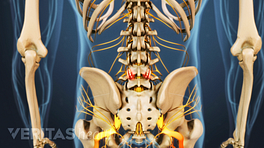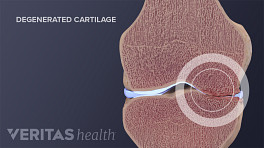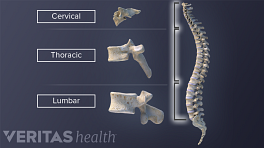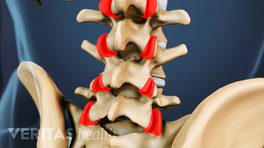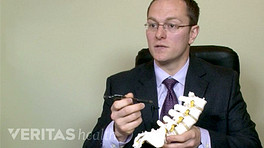In order to understand the function of a facet joint, we need to know a little bit more about the anatomy of the spine.
Now I'm holding here a model of the lumbar spine. And you can see here is the front of the spine, and here is the back of the spine. And these are the bony spiny processes that you can feel as you run your hand down the back of someone's spine. And this is the back here, this is the sacrum.
Now, within the lumbar spine for example, the lower back, you have the vertebral bodies. Usually there's five vertebral bodies in most people. Numbered one, two, three, four, and five.
On the back of the spine here, you see as we mentioned the spinous processes here. And nestled in between the vertebral bodies, which is the building block of the spine stacked one on top of the other, and the spinous process on the posterior end, you see what is called the facet joint. The facet joints runs in pairs down the entire spine on each side. And the facet joints are true synovial joints. They have a synovial membrane and the allow for motion of the spine. The orientation of the facet joint dictates how that facet joint will allow motion.
As you can see in the lumbar spine the orientation is on this plane here. Where you can have some better some flexion and extension of the lumbar spine.
In the neck there's also facet joints, but they are oriented quite differently. You can see here at the base of the skull and here is the back of the spine, so we're looking towards the back of somebody here.
And these are the facet joints, and although they look very different, they serve the same function, they allow for the free movement of the spine, but they also provide support and stability.
They also prevent certain motions that would perhaps be detrimental to the spinal cord. The spinal cord is encased within the spine. As you can see here, this yellow representation here, is the spinal cord running down the central canal, with the spinal nerve roots that come out at each level.
Now, the facet joints over time are particularly prone to wear and tear, it's a degenerative disease. Especially if there's a traumatic incident at some point or points in our lives, which generally speaking the facet joints can become very arthritic.
It's important to realize that in every person, if you live long enough, you're going to develop facet joint arthropathy or facet joint arthritis. And that's a normal occurrence, and that happens in absolutely everybody pretty much without exception if you live long enough. And that's because wear and tear on a joint is the normal process of aging. It doesn't necessarily mean you're going to get pain from that joint.
However in certain individuals, and often times starting at a very young age, the facet joints themselves, these paired joints in the spine, whether it's lumbar, thoracic or cervical can cause an inflammatory process which causes pain not only in the facet joint and perhaps surrounding capsule, not pictured here, but also pain that then can be found in the muscles surrounding the facet. The reason for that is that when there is pain in the facet joint, there is a self-protective mechanism that the body uses by sending the surrounding musculature, the para-spinal muscles, into spasm to better protect the arthritic joint. But unfortunately this isn't the best mechanism because often times it leads to decreased function, flexibility, and more pain.
Now, in treating facet joint pain, it's often common to do a course of physical therapy, a course of maybe non-steroidal anti-inflammatories, exercise therapy, manipulations (whether it be osteopathic or chiropractic manipulations) can often times be quite helpful in a conservative treatment. When conservative measures fail, then you can employ another form of therapy, injection therapy to the facet joint or to the nerves leading to the facet joints.


